Lost and abandoned for a thousand years, the ancient medieval city of Tashbulak lies buried inches below the close-cropped grass of an isolated pasture high in the mountains of Uzbekistan.
Once a bustling mountain stronghold of the Qarakhanids — a nomadic civilization that conquered and controlled a vast central corridor of the Silk Road trade network — Tashbulak and its inhabitants have remained unknown and overlooked by modern archaeology.
When Washington University anthropologist Michael Frachetti first visited the site in 2011, he expected to find little more than remnants of small nomadic campsites. He and his Uzbek co-investigator, Farhod Maksudov, had made a last-minute decision to scout the high pasture after spending weeks in nearby valleys documenting ancient nomadic campsites as part of high-risk research funded by the National Science Foundation.
Using predictive computer models, they determined searching in the high mountains near the Tajikistan border should also yield discoveries. So they loaded their gear on donkeys and set off on a three-day excursion to the plateaus of the Malguzar range, more than 2,000 meters (6,500 feet) high.
“On the plateau, we found a hidden valley with large mounds and undulations on the surface, as well as an unusually large density of broken ceramics scattered across the structures,” Frachetti recalls. “It was obvious that the ceramics were ancient and probably medieval and that we had stumbled across something much larger and different from the typical campsites we had expected.”
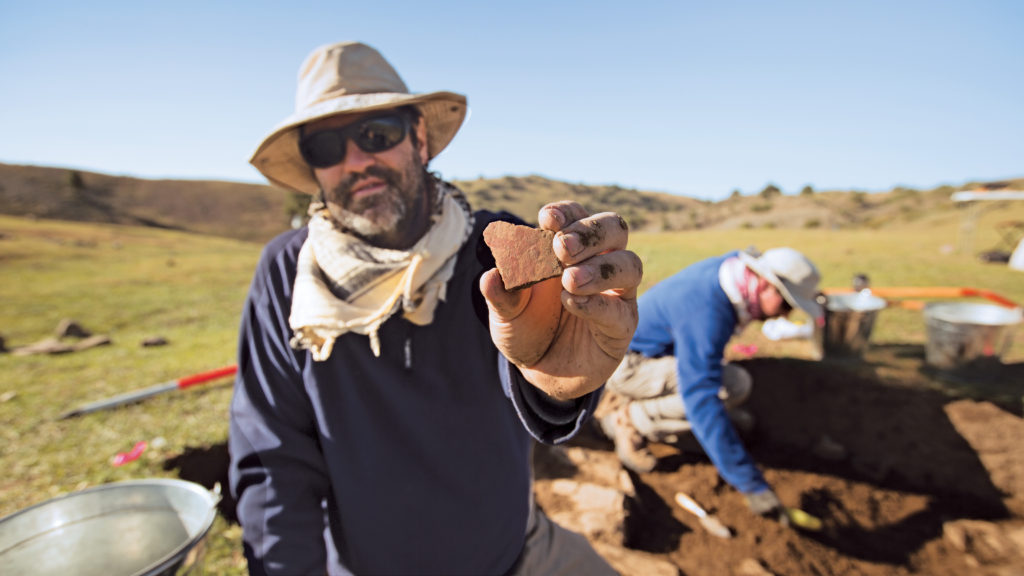
For Frachetti, an expert on Bronze Age nomadic pastoralists in Central Asia, the possibility of a large urban settlement at this high elevation was both surprising and intriguing. Nomads have summered their herds in these highland pastures for millennia, but most return to the foothills each winter.
Who were these people, he wondered, and why would they build a city so high in the mountains?
As Frachetti, Maksudov and their team of WashU graduate students walked the rolling green hills gathering tiny shards of ceramic, they traded theories about the history that might lie buried beneath their feet. What may have been harder to imagine, though, was the barrage of intellectual curiosity and scientific exploration their discovery would soon unleash on this remote corner of the Malguzar mountain range.
(Video by Thomas Malkowicz, Washington University Public Affairs)
Beyond their expectations
Frachetti, associate professor of anthropology in Arts & Sciences, began plotting a return visit with a small cadre of archaeological specialists, including current students and alumni who had worked with him on past field projects.
As director of the university’s Spatial Analysis, Interpretation and Exploration (SAIE) laboratory, Frachetti leads a team of scholars who use modern, high-tech analysis tools — Geographic Information Systems (GIS), remote-sensing and related technologies — in novel ways to explore how human societies have evolved. Specifically, SAIE researchers map, interpret and explore how global conditions and human history have been shaped by settlement patterns, resource capacity, cultural practices, and ecological interactions and other environmental factors, such as climate and climate change.
In Uzbekistan, pilot excavations the following summer, in 2012, revealed the stone foundations for several small buildings. This discovery fit with 3D topographic reconstructions of the site area based on aerial drone photography and computer modeling. Then with support from the National Geographic Society/Waitt Grants Program, the team returned in summer 2013 with an array of sophisticated remote-sensing equipment.
Led by Edward Henry, a WashU anthropology graduate student specializing in geophysical analysis, the team conducted a detailed magnetometer survey of the area, pinpointing small underground variations in the natural magnetic field. The sensitive instrument detects disturbed soils and decayed organic material and reacts strongly to burned soil, stones, iron, steel, brick and other buried materials.
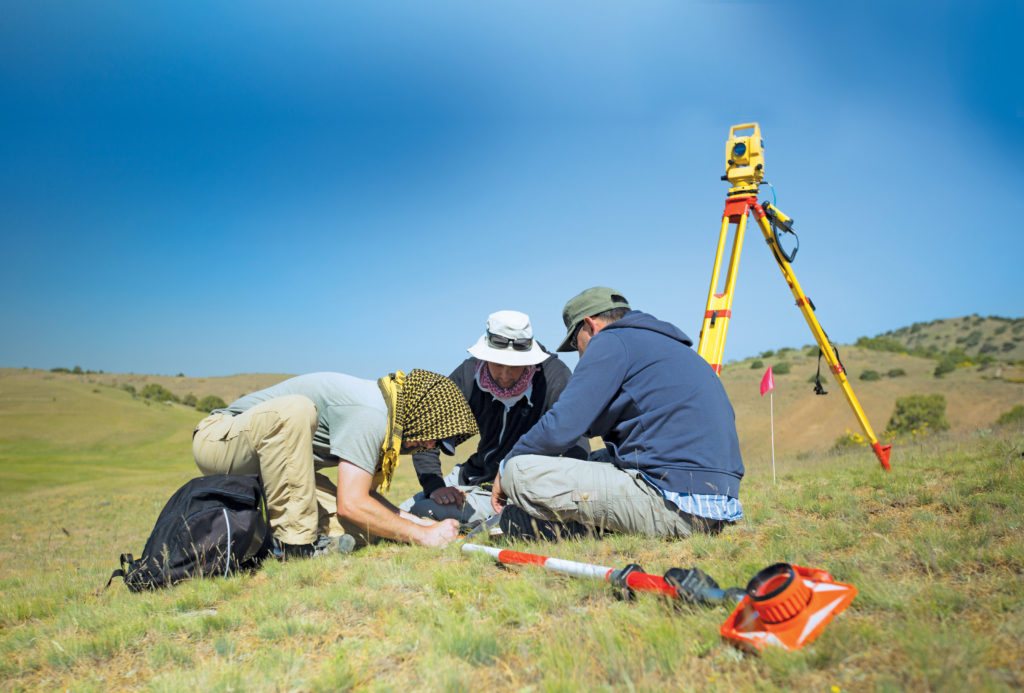
As Frachetti would later report to NatGeo, the preliminary survey had revealed the outlines of a settlement well beyond their expectations:
“We are excited to report that results of the gradiometer survey confirmed that the site is large and provides significant detail of [an] approx. 7-hectare town [little over 17 acres], complete with what we think are large water reservoir facilities, some defensive structures, an enclosed citadel, iron production areas, and a massive necropolis with roughly 300 burials. The whole town is well-preserved under about 50 cm [nearly 20 inches] of topsoil, has apparently never been looted, and was unknown until now to the archaeological or historical community. From an architectural perspective, Tashbulak is very complex, and given what we can see from the map, it reflects one of the best-preserved high-altitude production centers in Central Asia dating to the medieval period.”
A home for nomads?
The initial research at Tashbulak points to its foundation dating to 1,000 AD, when Central Asia was ruled by the enigmatic Qarakhanid empire. Much of what we know about the Qarakhanids is based on sparse accounts from historians living in lowland oases and river-delta cities that came under the control of this nomadic state. As the first Turkic nomads to convert to Islam, the Qarakhanids helped spread the faith across their vast empire, building impressive mosques and mausolea in cities across the medieval Silk Road.
Historians note the Qarakhanids had little interest in making big changes in the cities they conquered. Though their rulers and merchants may have set up shop in these lowland centers, nomadic Khans seemed content to leave earlier governmental institutions, agricultural systems and lucrative trade networks in place.
As Frachetti has shown in other research, nomadic pastoralists had roamed the arid foothills of these rugged mountain ranges for thousands of years before Marco Polo’s travels made the Silk Road famous. Each summer, they converged on the lush mountain pastures, reuniting with kinsman from nearby valleys and forging social connections that would lay the foundation for vast transcontinental trade routes.
Tashbulak, it appears, was the sort of city a nomad could call home.
Planning a large-scale expedition
Preliminary investigations had suggested the settlement was involved in the mining and smelting of raw iron ore, but many questions remain.
A veteran of excavations at sites across Central Asia, Frachetti knew that planning a large-scale archaeological expedition to such a remote site to try to answer these questions would be challenging.
Were the settlement’s blacksmith shops and craft buildings used to produce luxury metal goods for the elite in the nearby citadel, or was there a military purpose for the production, such as new forms of steel for the blades of knives and swords? Did people live at the site year-round? And, if so, how did they manage to feed themselves and their herds when winter snows piled up as high as 8 feet? Why, after hundreds of years of apparent prosperity, was the site so suddenly abandoned?
A veteran of excavations at sites across Central Asia, Frachetti knew that planning a large-scale archaeological expedition to such a remote site to try to answer these questions would be challenging.
Populated by a handful of nomadic herdsmen (and their huge herds of cattle, sheep and goats), the high pasture is a full-day’s bus ride from Samarkand, Uzbekistan, the nearest city with a commercial airport. Americans making the trip would spend a day in the air just getting to Samarkand, with stops in Dusseldorf, Germany, and St. Petersburg, Russia.
The site also lies within a restricted military zone along the border with Tajikistan, so the travelers first would have to obtain high-level government security clearances. With little nearby access to medical attention, commercial lodging and food markets, every item essential to the expedition (and the subsistence of its crew) would need to be stockpiled and transported to the site along with the researchers.
With grant support from the International Center for Advanced Renewable Energy and Sustainability (now known as the International Center for Energy, Environment and Sustainability or InCEES) at Washington University and the Max van Berchem Foundation, Frachetti began recruiting multidisciplinary scholars to help explore the site in greater detail and address two other central questions: How did the construction of a large town at high elevation impact the environment in this fragile landscape? And how did it function in the political and economic system of the medieval Silk Road?
In the summer of 2015, Frachetti drew together a team of nearly two dozen researchers and support staff, who assembled in Samarkand. They set out for Tashbulak in a Russian bus that — when on site — transforms into a science lab for high-tech processing in the field. Besides the “Science Bus,” the team lived in much the same way as the nomads that preceded them. They set up a tent camp near the dig site, dug a latrine and engineered an ecologically sustainable water-filtration system to pump water from a nearby spring for drinking, showers and laundry.
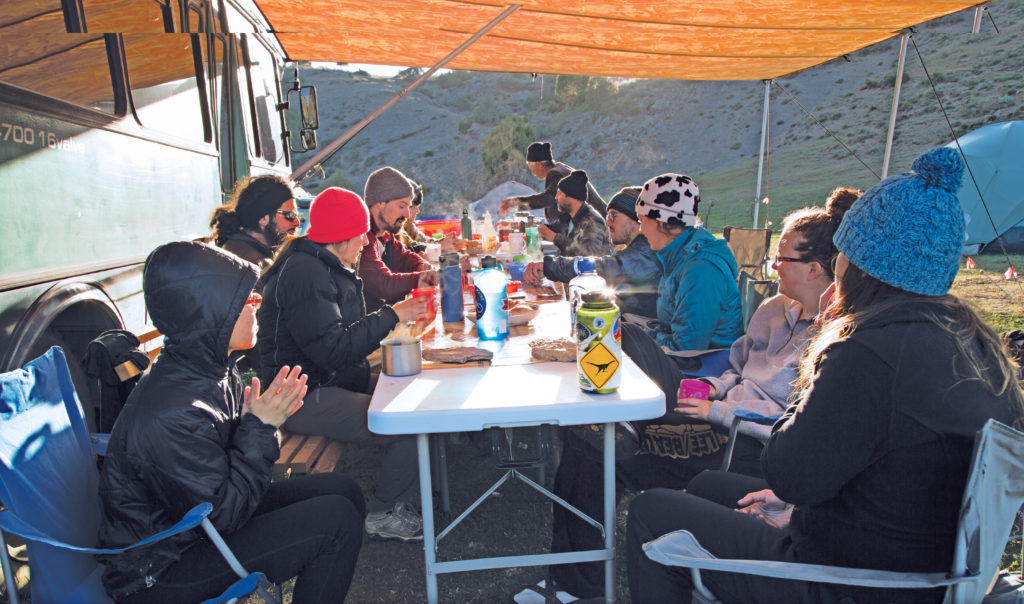
The team’s specialists were organized into four focus groups whose methods are honed for broad areas of interrelated analysis: remote-sensing and site architecture, mortuary excavation, plant bioarchaeology, and environment and sustainability.
The remote-sensing group was sponsored by the National Geographic Society Committee for Research and Exploration. And Frachetti once again tasked geophysical specialist Edward Henry to organize researchers to carry out extensive ground-penetrating radar surveys across a larger area of the settlement.
Now in his fifth year of the anthropology doctoral program, Henry, MA ’14, has used his specialized skills to reveal archaeological secrets buried deep within the earth from Central Asia to Mexico to Arizona, as well as many states in the Eastern U.S.
“With ground-penetrating radar, one characteristic we’re looking at is a difference in the density of the earth: things like mud-brick structures or stone foundations, which will reflect differently than the naturally occurring soil next to them,” Henry says.
“Using Ed’s data, we are able to carry out more strategic excavations targeting specific areas, as opposed to opening up huge trenches and wasting a lot of time and resources.”
— Michael Frachetti
Henry’s meticulous, grid-by-grid surveys of Tashbulak helped the team gain a better understanding of the city’s layout and organization. Equally important, Frachetti says, the surveys showed them exactly where to dig.
“Using Ed’s data, we are able to carry out more strategic excavations targeting specific areas, as opposed to opening up huge trenches and wasting a lot of time and resources,” Frachetti says.
In 2015, the group targeted archaeological excavations on a blacksmith workshop in the lower town, a trash heap, five burial plots in the necropolis and a portion of a residential structure on the citadel. The central building of the citadel, which shares the design of other palaces in the region, was constructed with a thick stone foundation measuring 60- to 70-centimeters wide at its base. Much of the soil near the bottom of the wall showed signs of intense burning, suggesting that the whole structure may have come down in a huge fire, Frachetti says.
Digs at the metal workshop uncovered slag from iron-ore processing, as well as fragments of iron weapons and tools. Along with abundant ceramics, glazed wares, glass beads, a silver vessel and other household items, researchers recovered a number of Qarakhanid coins dating to about 975 CE, or roughly 25 years after the conversion to Islam is believed to have swept across the Qarakhanid civilization.
(Video by Thomas Malkowicz, Washington University Public Affairs)
Unearthing more questions
This religious influence also is evident at Tashbulak’s large, 300-grave hillside cemetery, where excavations confirmed the use of a distinctly Islamic burial style.
“What’s interesting about the Tashbulak site, and the Qarakhanid dynasty in general, is that there hasn’t been a bioarchaeological study of this population,” says Elissa Bullion, an anthropology doctoral student who is overseeing the mortuary excavation group. “We have historical records that tell us about who these people were to some degree, especially the more urban populations and the more elite echelons of society. But we don’t know a lot about the ordinary people who were living under the dynasty, especially on a day-to-day basis.”
(Video by Thomas Malkowicz, Washington University Public Affairs)
Also in her fifth year of the anthropology doctoral program, Bullion, MA ’14, is hoping the bones her team unearths at Tashbulak will help history better understand the daily lives of herders, blacksmiths, soldiers and other working-class people who lived in the city.
A native of eastern Massachusetts, Bullion did excavations in Peru as part of her undergraduate anthropology studies at Middlebury College in Vermont. She did fieldwork in Mongolia before coming to WashU on a Mr. and Mrs. Spencer T. Olin Fellowship for Women in Graduate Studies.
Her specialization, also known as human osteoarchaeology, involves the scientific excavation, recording, recovery and analysis of archaeological human remains to answer questions such as age, sex, diet, health, occupation and ancestry.
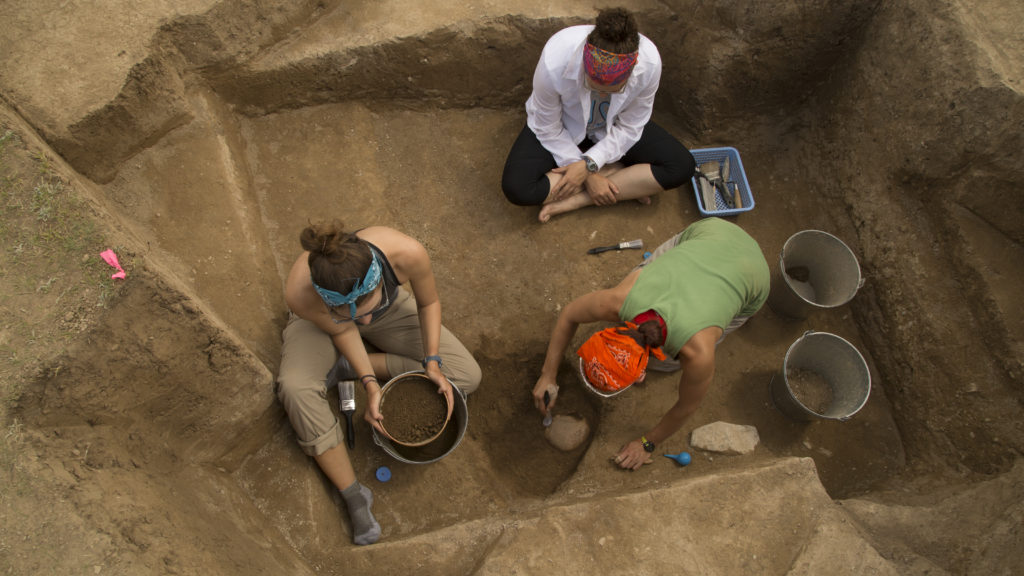
During their 2015 visit, Bullion, a team of WashU undergraduate students and Uzbekistan colleagues excavated five graves, which included the remains of four adults and one infant. She plans to return to the field this summer to excavate as many as 30 additional graves, which will help her explore Tashbulak’s demographic profile and population genetics.
As research progresses, Bullion will collaborate with leading specialists to do morphological evaluations of bone size, shape and condition, and other analyses at the molecular and genetic levels to see what stories these bones may tell about residents’ lifestyles.
“Certain stages of metal production require specific types of heavy physical labor,” she says. “This can create observable patterns of wear and modifications on bones. When we combine these patterns of pathology with other lines of evidence, such as metal signatures in bone chemistry, we can build a picture of whether individuals were engaged in metal work and, if so, which stages they were involved in.”
Plant remains provide clues
A third group focused on other remains, the ancient plants or archaeobotany of the archaeological site and the ancient environment. Led by research scientist Robert Spengler, MA ’09, PhD ’13, the team was charged with sifting through excavated soils for seeds, pollen and other signs of food crops that may have been cultivated at the site or transported there from agricultural settlements at lower elevations.
(Video by Thomas Malkowicz, Washington University Public Affairs)
For Spengler, a small peach pit excavated from Tashbulak is yet another puzzle piece in his larger quest to understand how modern crops made their way to dinner tables around the globe.
“Finding a single peach pit is very exciting because it is a crop that is coming from Far East Asia,” Spengler says. “We see the Silk Road exchange networks bringing more than just silk. We see a whole variety of crops, which through the process of globalization, become key players in agricultural traditions across the entire Old World.”
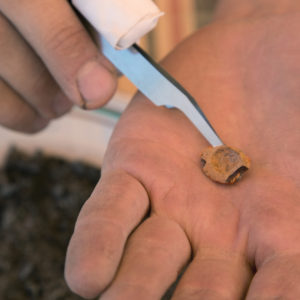
Spengler began his graduate studies in 2006 under the mentorship of noted WashU archaeobotanist Gayle Fritz. He honed his interest in the paleoeconomy of Central Asia while working with Frachetti at several excavation sites. He now continues to collaborate on diverse research projects in Kazakhstan, Uzbekistan, Turkmenistan, China and Mongolia.
Spengler’s research at Tashbulak is showing what kinds of fruits, grains and legumes were carried to Tashbulak from Silk Road market bazaars by ancient merchants. Many of these ancient Silk Road fruits, such as peaches and apricots, originated in distant parts of the world, while others, such as the apple, were domesticated in the foothills of Central Asia.
Reconstructing the past
Spengler also contributes to the InCEES-funded [formerly I-CARES] environmental research group, which is led by two other WashU experts: T.R. Kidder, the Edward S. and Tedi Macias Professor and chair of anthropology in Arts & Sciences; and Dan Giammar, the Walter E. Browne Professor in Environmental Engineering in the School of Engineering & Applied Science.
The environmental group is exploring the relationship between rapid settlement intensification, metal production and herding economies at Tashbulak, all of which may have contributed to deforestation, flooding and heavy-metal pollution.
(Video by Thomas Malkowicz, Washington University Public Affairs)
The aim of the InCEES [formerly I-CARES] support was to bring a multidisciplinary approach with experts on dendroclimatology, archaeobotany, geoarchaeology and geochemistry, environmental isotopes and GIS to model and track environmental changes going back more than a thousand years.
A key player in the environmental investigation is Taylor Hermes, who graduated from WashU in 2007 with an undergraduate degree in anthropology. Now a PhD candidate in archaeology at Kiel University in Germany, Hermes has worked with Frachetti on excavations for more than a decade. At Tashbulak, Hermes is a leader of the cartographic team that handles GIS site-mapping and topographic analysis. He’s also directing the isotopic analyses of recovered animal bones and teeth to reveal clues about environmental conditions at the site and the role of livestock in its economy.
“My main interest at Tashbulak is to understand the pastoral production of the site’s past inhabitants and to reconstruct aspects of the paleoclimate,” Hermes says. “I’ll analyze carbon, oxygen, nitrogen and strontium isotopes to reconstruct the background environment and how these isotopes moved through the ecosystem via various animal-management strategies and eventually got deposited in the mineralized teeth of the cattle, sheep and goats that were herded here.”
Back at his lab at Kiel, Hermes uses a mass spectrometer to measure the isotopic signatures of ancient teeth, bones and carbonized plant remains excavated at the site and compare them to modern samples he collected near Tashbulak and from surrounding sites. Since the teeth of sheep and related species grow at a relatively steady rate, he hopes the seasonally varying isotopic signatures in the enamel will provide insights about whether the site was occupied year-round and how herders used the surrounding landscape to support their animals.
Irina Panyushkina, a leading paleogeographer and dendroclimatologist from the University of Arizona, leads the study of long-term climate-change analysis based on examining tree rings from ancient and modern wood samples collected at the site, which also contributes to Spengler’s research.
“A huge component of our work here is reconstructing what the environment looked like in this time period,” Spengler says. “The intertwining of forest depletion and soil erosion, possibly the toxic buildup in the soil through metal production, will show up in the botanical record.”
Giammar, who brings expertise on the environmental transport of heavy metals, is collaborating with Zezhen Pan, a doctoral student in Giammar’s aquatic chemistry lab, to determine whether iron production may have contaminated soil, water and crops in and around Tashbulak.
Yi-Ling Lin, a McDonnell Scholar and anthropology doctoral student, collaborated with Kidder on site-wide soil sampling and on the analysis of soil sediments they excavated near an ancient stream bed that once flowed through Tashbulak.
Yi-Ling has since partnered with Giammar and Zezhen to conduct related research on possible soil contamination from bronze production at an ancient site in China.
“This is going to be a long-term project: As we study the samples we’ve brought back and do various measures, we come up with new questions. Then we’ll need to go back to get more samples.”
— T.R. Kidder
Kidder points to this forthcoming research as an example of how fieldwork at Tashbulak and other sites provides WashU students with incredible opportunities to forge collaborative research partnerships with faculty and students from other disciplines, out in the field and in the lab.
“A lot of our fieldwork needs to be resolved in the lab,” Kidder says. “This is going to be a long-term project: As we study the samples we’ve brought back and do various measures, we come up with new questions. Then we’ll need to go back to get more samples.”
Looking ahead, Frachetti is planning future WashU research at the site in close partnership with Maksudov and other archaeologists from the Uzbek National Academy of Science’s Institute of Archaeology. With a commitment of some continuing funding already in hand, Frachetti and his colleagues are mounting their next large-scale expedition for summer 2018.
“We are optimistic about the capacity to fund and execute truly groundbreaking research on urbanism and Silk Road trade in Uzbekistan for at least the next five years,” Frachetti says. “The impact of the Silk Road on global culture is unarguably immense. We think that with a long-term, sustained research effort, we can deploy the talent and technology of WashU to expose an effectively unknown ancient empire to the world. We aim to illustrate how ancient civilizations — not unlike our own — expand and change the nature of interaction when diverse communities integrate into shared networks. For the medieval Qarakhanids, this meant integrating nomads and farmers, mountain-herders and urbanites, and traders and craftsmen with leaders across a diversity of ideologies. Understanding how cities and networks functioned successfully for centuries in this precarious premodern environment might give us optimism for the future of our own initiatives of global community-building.”


